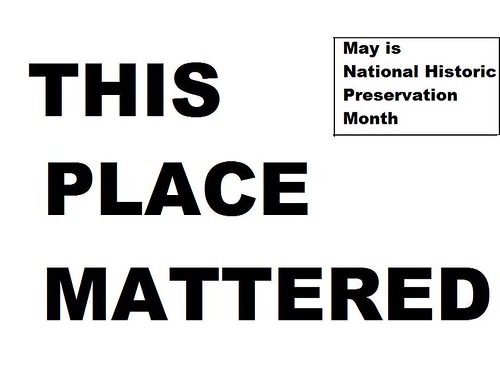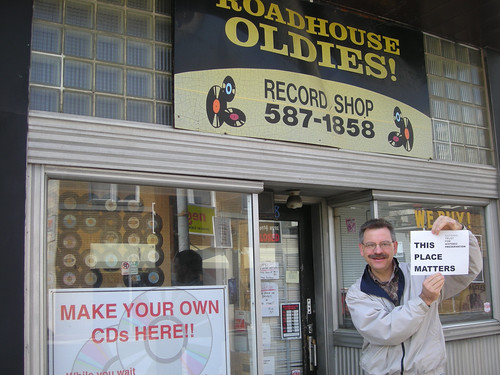This place mattered #1: May is National Historic Preservation Month

Jerry McCoy, president of the Silver Spring Historical Society and a professional librarian, has followed and/or been involved in historic preservation matters in DC and Montgomery County for the last few decades (e.g., he has a sad collection of great photographs that he took of buildings being demolished downtown).
He took me to task on my recent blog entry, "More than 29 ways to support historic preservation month (May) in DC," which is pretty positive (belying my true feelings), about how to "celebrate" preservation.

Jerry writes a history column in the Silver Spring Voice newspaper, and his May column is about how Silver Spring continues to lose commercial buildings that reflect its art deco heritage. He titled the column "These Places Mattered." The column isn't yet online, but it starts with this:
May is here and time again for communities across the nation to celebrate National Preservation Month. The theme for this year’s campaign, organized by the National Trust for Historic Preservation to raise awareness about the power historic preservation plays in protecting the uniqueness and heritage of communities, is “This Place Matters.”
Because of the lack of historic preservation in downtown Silver Spring, I’m compelled to alter this theme to “These Places Mattered” due to the continued destruction of our community’s earliest buildings as part of ongoing “revitalization.”

Storefront facade, now demolished, Roadhouse Oldies record shop, Silver Spring. (Jerry McCoy is in the photo.)
Now in April, I wrote two other pieces on preservation that I wouldn't consider positive, at least about the state of the field in our region, which is under constant attack in DC as well as in Montgomery County, Maryland, where the Councilmember who chairs the committee on planning has introduced legislation that would gut many of the provisions of the legislation:
-- The house as a haven and refuge, nimbyism, and urban-ness
-- May is National Preservation Month...
As I keep mentioning, I am reading Cameron Logan's dissertation on historic preservation and planning in DC from 1950-1990. I don't know yet if there are copies at the Washingtoniana Collection at the Martin Luther King Central Library or at the Historical Society of Washington.
Anyway, he writes about what he interprets as the three primary responses on the part of preservationists beginning in the 1980s to the successful response by developers to constrain the effectiveness of preservation at warding off change/development, especially downtown--the developers arguments were that the city needed development for social welfare reasons. This was a particularly good strategy to use race to divide the progressive impetus.
The responses were (1) continued protest (Rhode's Tavern activists) from outside the system; (2) semi-co-optation, working with builders (DC Preservation League, control of their board by real estate interests); and (3) "professionalization" of the field and integration of preservation efforts into normal planning and development processes.
I think there is fourth potential response, a reinterpretation of preservation around not just livability and historicity issues, but around economic development and how it contributes to the competitive advantages of the center city. But this "fourth" approach, one that I guess I advocate for, is one that hasn't been taken up on the part of preservationists.
In both Downtown Washington and in Silver Spring, traditional urban renewal strategies, which have little truck for preservation, have been the norm.
There is no question that for the most part, preservationists have not adopted this fourth thrust (despite it being the focus of books such as Changing Places by Moe and Willkie as well as two books by Roberta Gratz, The Living City and Cities: Back from the Edge--each of these books is well worth reading, and I argue that city dwellers, if they are going to read only one book about how to do revitalization right, they should read Cities: Back from the Edge), or at the very least, preservationists at the local level have not been very good at articulating this point, making the case for historic preservation along these lines. Instead, many developers with the able assistance of their land use lawyers continue to be quite good at keeping the waters roiled by making preservation and preservationists out to be obstructionists not concerned about the good of the city and the future.
(This is abetted by the idea of preservation as being completely opposed to any change whatsover versus being a bit more flexible in recognizing that some buildings are less important than others, and maybe change in particular areas can provide new strengths to neighborhoods and the city. And that doesn't even get into the idea of preservation of culture--people--rather than the focus on buildings. It is this issue that the developers have been good at using to make preservation out as a movement of rich whiteys looking for strategies to displace the poor.)
As far as the city's competitive advantages are concerned, I aver that DC has five competitive advantages of which three are related to historic preservation:
1. historic architecture (and neighborhoods);
2. pedestrian centric urban design (hailing from the Walking and Transit City eras);
3. history, identity and authenticity;
4. a rich transit infrastructure that allows for efficient mobility that is not car-dependent; and
5. the steady employment engine of the federal government.
Certainly this is an issue in Montgomery County as well. There probably isn't the same appreciation for historic preservation, given that the dominant narrative of MoCo is centered around automobility, outmigration from the center city (i.e., the video that appeared on WETA-TV about Silver Spring which is very much enthralled with automobility), and the idea of suburban expansion and the cult and fashion of the new in terms of new construction being superior to the "old."
And of course, as weak as this ethic might be, it's being battered further by the pro-development forces led by the efforts of MoCo Councilmember Michael Knapp and his efforts to further weaken Montgomery County's Historic Preservation legislation.
I do think that the new MoCo Historic Preservation Design Guidelines are a big step forward, by adding a section on the narrative themes of the county's architectural history as well as two-page writeups on each historic district, this helps place preservation and history in context.
However, I think that those guidelines need an additional chapter, on the value of historic preservation both from a sense of place standpoint (along the lines of the report Contributions of Historic Preservation to Quality of Life in Florida, 2006, Executive Summary and Technical Report) and the economic power (the work by Rypkema, such as Economic Power of Historic Preservation) of preservation and its relevance to urban competitive advantage.
Not that DC does a version of its preservation guidelines and history along these lines either. But it's something I have on my list of things to try to mock up...
Jerry's column concludes thusly:
Along with the loss of these historic buildings add the 1998 demolition of the 1927 Maryland National Guard’s Silver Spring Armory on Wayne Avenue, despite being “protected” by virtue of being listed on Montgomery County’s Master Plan for Historic Preservation; the 2003 demolition of the 1950 Blair Station post office on Newell Street, eligible for listing on the National Register of Historic Places; the 2009 decision by our Montgomery County government to allow the total demolition of the north parcel of the 1937-38 Falkland Chase Apartments on East-West Highway, featuring 182 Colonial-Revival style garden apartments situated on nine rolling acres of mature trees bisected by a stream bed valley park that is eligible for National Register listing; and the imminently endangered 1958 International style Perpetual Building Association at 8700 Georgia Avenue, the best example of Mid Century commercial architecture in Silver Spring. All of this history either lost or endangered during the span of a decade. What community landmarks will we loose in the next ten years?
I urge you to “speak” up and share with others the places in Silver Spring, or anywhere else in the United States, that matter to you. Currently only five Silver Spring locations are featured on the National Trust’s “This Place Matters” photo web site. Certainly there are other places in Silver Spring that matter to folks besides the currently listed Roadhouse Oldies, Nolte Field, Kefa Café, Tastee Diner, and Forest Glen Seminary? PLEASE contribute your images to “This Place Matters” by joining the “This Place Matters” group on Flickr. You can download your free official “This Place Matters” sign. If you do not want to join Flickr then email your photograph to me along with a few sentences detailing why the place matters to you and I will gladly add it to the site.
Without more visible, energetic, and ardent support by you, the public, to preserve and reuse Silver Spring’s living history, our community is well on its way to looking like Anywhere USA.
This goes for Washington too... If you don't work to understand, respect, preserve and respectfully adapt what should be considered historic buildings, architectural legacy, and the nation's patrimony, more and more of the city will be not much more than an ersatz outdoor shopping mall and residential subdivision. It should be clear that here is no competitive advantage present in such a scenario.
Labels: historic preservation



0 Comments:
Post a Comment
<< Home